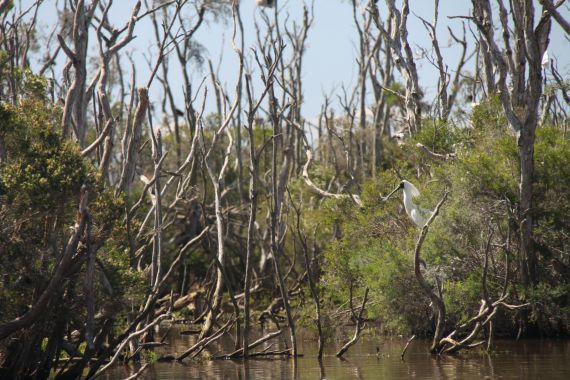The results of a spectacular breeding season were on show across the lower Latrobe wetlands in autumn 2022 with the water humming with scores of waterbirds, fish, frogs and eels.
The booming season was a great indicator of the ongoing recovery of these internationally-significant landscapes, with help from water for the environment.
The lower Latrobe wetlands, located just outside of Sale in East Gippsland, include Sale Common, Dowd Morass and Heart Morass and form part of the broader Gippsland Lakes Ramsar site.
Each of the wetlands provide an important function for native plants and animals. Put simply, Dowd Morass is the housing estate where everyone lives, Heart Morass is the supermarket where everyone goes shopping, and Sale Common is the holiday destination.

Image: Royal Spoonbill at Dowd Morass, by West Gippsland CMA
A shared responsibility to care for these wetlands
The freshwater fringing wetlands to the Gippsland Lakes play a vital ecological role but the legacy of upstream river modifications, water extraction, poor land management practices and climate extremes had seen large sections of the lower Latrobe wetlands become increasingly brackish and saline.
But, over the last decade, water and land managers and local communities have worked together to repair the wetlands, including the introduction of water entitlements held for the environment.
After over 10 years of delivering water for the environment to the lower Latrobe wetlands, Sale Common saw Australasian Bittern return in 2019 for the first time since the 1990s. Heartened, community members began water quality monitoring in 2020 focussing on Heart Morass where a lot of land management improvements were underway.
Monitoring showed adaptive water and land management at Heart Morass had improved water quality. Shifting the pH dial towards neutral and salinity levels towards freshwater primed the wetland to respond in full splendour to the natural flooding that occurred during 2021.
“Good rainfall and natural flows complement long-term deliveries of water for the environment to revive rivers and floodplains, providing life support for native plants and animals,” VEWH Co-CEO, Beth Ashworth, said.
The 2021 floods flushed freshwater through the system and out into Lake Wellington, building on the groundwork deliveries of water for the environment had established.
“Over the past years, we’ve been managing water for the environment through drought and fire seasons. This has essentially laid the groundwork to allow the environment to flourish when these natural flows came through,” West Gippsland CMA Environmental Water Officer, Dr Adrian Clements, said.
Conditions throughout 2021-22
The Latrobe catchment experienced above-average temperatures throughout most of 2021-22 and above-average rainfall during early winter and throughout spring (particularly during November) 2021 for a second consecutive year.
Significant flooding in June 2021 was followed by several smaller floods in late winter and spring. These floods as well as other high-flow events in the Latrobe, Macalister and Thomson rivers flushed the lower Latrobe wetlands for the first time since 2010-11, and salinity in Lake Wellington was at its lowest since 2004.


Image: Above - Sale Common in July 2021, Below - Sale Common in December 2021, by West Gippsland CMA
Water for the environment prepared for and complemented natural flows for the lower Latrobe wetlands.
In addition to providing critical freshwater habitat for the diversity of waterbirds in the wetlands, changes in water levels influence the type of food available for each species to forage for at different times of the year – whether that’s picking worms from the mud in lower water levels in summer or chasing moths through the reeds at higher levels in spring. Variation in the water flow also helps maintain the vegetation at the right height at the right time for bird nesting.
Environmental watering has been particularly important in sustaining waterbirds and vegetation during drier years, so they’re in better condition and numbers to keep breeding and flourishing when conditions get better.
“We manage water for the environment within a bigger picture of keeping things going in dry times so the environment can have a ‘boom cycle’ when nature delivers rains such as in the past year,” Dr Clements said.
“Despite the wet year, we continued to plan for environmental flows on key waterways and simply adjusted them to suit the rainfall conditions. Water for the environment when it’s wet is important to build strong and resilient rivers and wetlands to prepare them for future dry years.” he said.
Successful outcomes showing results of years of planning water and land management
In 2021-22, alongside the Australasian Bittern return, there were over 300 nests spotted and attributed to Australasian Darter and colonial waterbirds including Royal Spoonbill, Yellow-billed Spoonbill, Little Pied Cormorant, and Little Black Cormorant. This is the largest breeding event since 2012. In addition, increased numbers of Musk Ducks have been seen in the lower Latrobe wetlands – this freshwater-dependent species is culturally significant to the Gunaikurnai Traditional Owners.
Monitoring in March 2022 revealed another boom year for native animal breeding events in the wetlands including endangered Growling Grass Frog and Green and Golden Bell Frog recorded for the first time breeding at Heart Morass. Also responding to the natural and environmental flows have been freshwater-dependent vegetation not seen at these sites in decades, such as Eel Grass (also known as Ribbon Weed).
In addition, fishers noted a marked increase in Estuary Perch and Australian Bass indicating breeding and migration events in 2020-21. For the Australian Bass, Australia’s longest-lived fish species, this was the largest breeding event in the Latrobe system since the 1980s.
Delivering water for the environment has prepared these important wetlands for the ‘boom times’. Environmental flows will continue to be delivered in response to emerging conditions. Coupled with robust water quality monitoring and strong community participation, the future of the lower Latrobe wetlands is in safe hands.